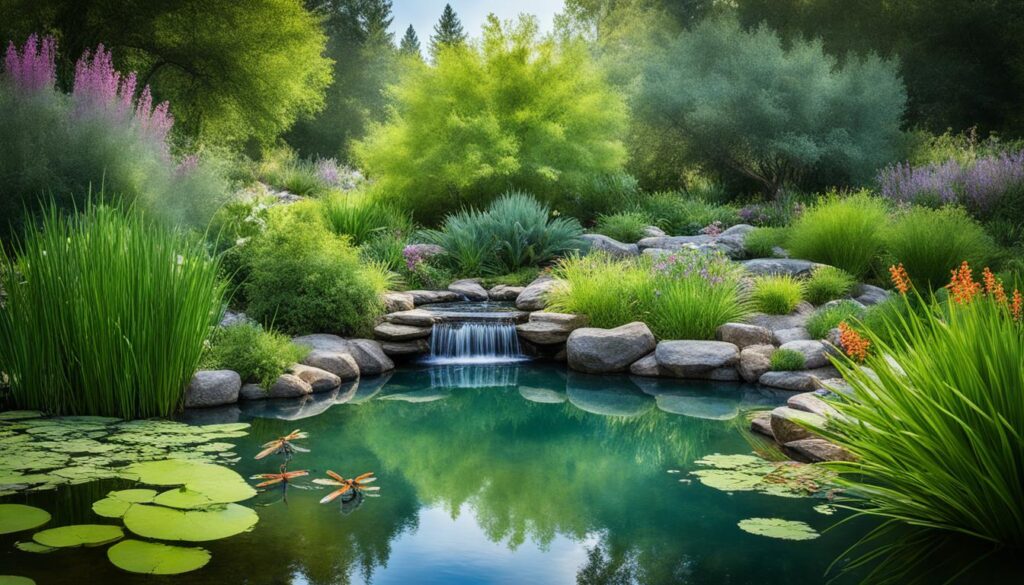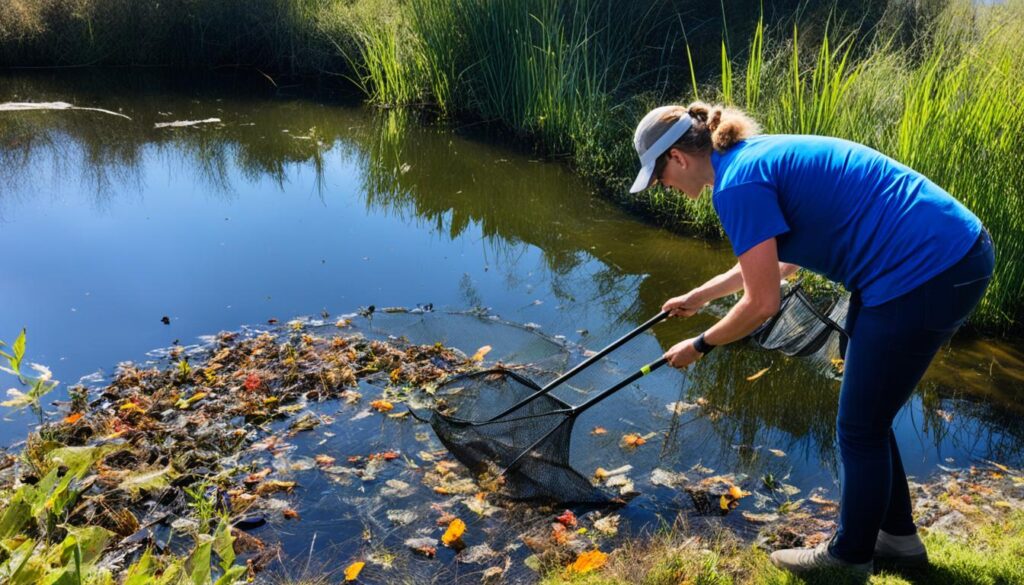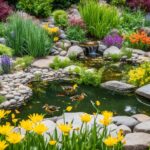Building a Wildlife Pond for Biodiversity
Are you ready to make your backyard a thriving ecosystem? A wildlife pond could be the perfect choice. By adding a natural water feature, you’ll attract many species and boost your garden’s biodiversity. But what makes a wildlife pond different from a regular pond? Let’s dive into the world of these eco-friendly water features and see their benefits.
Key Takeaways
- Wildlife ponds create a habitat for a diverse range of species, supporting biodiversity in your garden.
- These natural water features require minimal maintenance, making them a sustainable and eco-friendly addition to your outdoor space.
- Unlike ornamental ponds, wildlife ponds focus on providing a natural environment for plants and animals, rather than aesthetic appeal.
- By incorporating a wildlife pond, you can transform your backyard into a thriving ecosystem that supports pollinators, birds, and other beneficial wildlife.
- Building a wildlife pond is a rewarding project that can enhance the overall health and vibrancy of your garden’s ecosystem.
What is a Wildlife Pond?
A wildlife pond is a special place above ground that helps many different kinds of animals. It’s not just for looks; it’s a home for birds, insects, amphibians, and more. This pond gives them food, water, and a safe place to live.
Benefits of a Wildlife Pond
Having a wildlife pond brings many advantages:
- It draws in lots of native plants and animals to your yard
- It supports a healthy aquatic ecosystem with its natural features
- It’s a beautiful, easy-care natural water feature for your outdoor area
Difference from Ornamental Ponds
Unlike ornamental ponds, which often have exotic plants and fish, a wildlife pond is made to be self-sufficient. It’s a balanced home for nature. Ornamental ponds don’t help support a diverse wildlife habitat like a wildlife pond does.
“A wildlife pond is a thriving, self-sustaining haven that brings the beauty of nature right to your doorstep.”
Choosing the Right Location
Choosing the right spot for a wildlife pond is key. Don’t put it in the front yard where kids might get hurt. Instead, pick a spot in your backyard or side garden that gets some shade. This garden placement keeps the pond cool for animals on hot days and stops algae growth.
Think about keeping kids safe too. Put your pond where it’s not in the way of where kids play. This way, kids stay safe and nature gets a home. A good pond spot can make your outdoor area special. It lets you and your family enjoy the wildlife accessibility and the peaceful sound of water.
“The perfect location for your wildlife pond is one that balances safety, sun exposure, and accessibility for the creatures you hope to attract.”
Look for spots that get some shade all day. This keeps the water temperature steady and makes it better for animals. Also, pick a place you can easily get to for upkeep, but not too close to where people walk by a lot.
By picking the right spot for your pond, you make a beautiful outdoor space. You also give a safe place for plants and animals to live.
Container Options for Your wildlife pond
Choosing the right container for your wildlife pond is key. It should be at least 18 inches wide and 5-8 inches deep. This size lets native aquatic plants grow well. You can use recycled containers that work great for this purpose.
Repurposed Firepits and Tubs
Old metal tanks, utility tubs, and repurposed firepits can become beautiful wildlife ponds. They are strong, won’t leak, and are perfect for your backyard. They help native plants grow and are safe for local wildlife.
Lining Porous Containers
If your container is made of porous materials like concrete or clay, line it with a good pond liner. This stops leaks and keeps the pond clean. It makes sure your pond is a safe place for wildlife.
Picking the right container and waterproofing it well makes a great wildlife pond. It will draw in many local species and boost your outdoor area’s biodiversity.
| Container Type | Advantages | Considerations |
|---|---|---|
| Metal Stock Tanks |
|
|
| Repurposed Firepits |
|
|
| Utility Tubs |
|
|
“The key to a successful wildlife pond is finding the right container that can safely and securely hold water while supporting the growth of native aquatic plants.”
Selecting Native Plants
Creating a thriving wildlife pond means picking native aquatic plants. These plants are key to the pond’s biodiversity. They feed, shelter, and give oxygen to many species you want to attract.
But, be careful with non-native and invasive species. They can upset the pond’s balance. Choose native plants that fit your area well. This ensures a pond that’s in harmony with local wildlife.
Importance of Native Aquatic Plants
Native aquatic plants are crucial for a healthy wildlife pond. They feed many creatures, from insects to birds. They also give cover and shelter, helping young ones grow.
These plants are key to keeping the water oxygenated. This keeps the aquatic ecosystem healthy. By picking these plants, you help create a pond that looks after itself and supports many native species.
Avoiding Invasive Species
It might be tempting to try exotic plants, but avoid invasive species in your wildlife pond. They can crowd out native aquatic plants, harming the biodiversity you’re trying to keep.
Talk to local experts or a trusted nursery to pick the right plants. They can guide you to plants that do well in your area and support your pond’s biodiversity.
What Not to Include in a wildlife pond
Creating a wildlife pond means avoiding the urge to add ornamental features. Unlike decorative ponds, a wildlife pond doesn’t need fish, filters, or chemicals. These can harm the wildlife you’re trying to help.
No Fish or Filtration Needed
Koi and goldfish eat native plants and animals, reducing biodiversity. Filters and aeration systems are also not needed. They can harm the delicate water environment. Let your wildlife-friendly design work naturally without adding ornamental features or chemical-free treatments.
“The best wildlife ponds are those that mimic nature, allowing the ecosystem to establish itself organically without human interference.”
Keep your pond simple and free from chemicals. This creates a home for many native species, like dragonflies, frogs, birds, and small mammals. Enjoy the natural beauty and balance of your wildlife-friendly pond.
Filling and Establishing Your wildlife pond
When filling your wildlife pond, think about the water sources. Use collected rainwater if you can, as it’s natural and free from chemicals. If not, let tap water sit for a few days to lose chlorine and additives.
Pay attention to the substrate as you fill the pond. Use soil, turf, or flagstones to cover the edges. This stops sunlight from breaking down the substrate and keeps it from mixing with the water. It’s good for the pond’s ecosystem.
Getting native plants to grow in your pond takes time, but it’s worth it. These plants are key for feeding and sheltering the pond’s wildlife. With patience, your pond will become a lively ecosystem.
| Water Sources | Substrate Management | Plant Establishment |
|---|---|---|
| Rainwater collection | Backfilling edges with soil or turf | Patience and time for native plants to thrive |
| Allowing tap water to sit for dechlorination | Preventing substrate dispersion | Essential for creating a balanced ecosystem |
Think about the water, substrate, and plants when setting up your wildlife pond. Doing so will help create a thriving pond that draws in many species. It will also give you hours of joy and a chance to connect with nature.

“The creation of a thousand forests is in one acorn.” – Ralph Waldo Emerson
This quote shows how a small, well-made pond can become a lively place for many species. With the right care, your pond will show the beauty and strength of nature.
Attracting Wildlife to Your Pond
After making your pond, it’s time to make it a hotspot for local species. Add habitat features to turn your pond into a lively spot. This will draw in frogs, dragonflies, birds, and small mammals.
Creating Cover and Shelter
It’s key to offer plenty of cover and shelter for a wildlife community. Think about adding these to make your pond a cozy habitat:
- Shallow spots along the pond’s edge for easy movement
- Placing rocks, logs, or branches for shelter and perches
- Emergent plants like cattails, rushes, and water lilies for cover
These elements make your pond more welcoming. They’re also vital for the biodiversity of your pond. They provide safe spots, nesting places, and perches for many species. This helps your pond become a balanced and lively place.
“A well-designed wildlife pond becomes a magnet for a diverse array of local species, transforming your backyard into a vibrant, living ecosystem.”
By picking the right habitat features for your pond, you’ll draw in many interesting wildlife. Your backyard will become a lively oasis.
wildlife pond Maintenance
Having a low-maintenance wildlife pond means you can let nature do its thing. Unlike fancy water features that need constant care, your pond will do well with natural processes. These processes keep the water clean and plants healthy. Try not to mess with it too much, as this can upset the pond’s balance.
Go for a hands-off approach and watch your pond grow. Just take out any big trash now and then, but let the plants and animals be. This way, your pond becomes a lively place that takes care of itself with little work from you.
By sticking with the low-maintenance side of your pond, you get to see its beauty and the variety of life it supports. It shows how powerful natural processes are. And it proves that a hands-off way of caring for your pond can lead to a lively, self-sustaining environment in your yard.

“The true beauty of a wildlife pond lies in its ability to thrive on its own, without the need for constant human intervention.”
Best Time to Build a wildlife pond
Creating a thriving wildlife pond depends on the right timing. Late summer or early fall is best. This lets plants grow strong roots and frogs find the pond before breeding starts.
If you can’t start in late summer, don’t worry. You can still make a great wildlife pond. Many species might still find and love it, even if it’s not the perfect time.
“The best time to plant a tree was 20 years ago. The second best time is now.” – Chinese Proverb
It’s important to balance plant and wildlife needs. Think about seasonal considerations, plant establishment, and wildlife activity. This way, your pond will be a lively spot for local wildlife.
Enjoying the Benefits of a wildlife pond
Having a wildlife observation pond is a great way to connect with nature. You can watch birds, insects, amphibians, and other wildlife up close. This lets you dive into the world of nature right from your backyard.
Being near water can also make you feel better mentally. It can lower stress and help you relax. Whether you watch the pond closely or just sit by it, it will become a special part of your outdoor space.
Wildlife Viewing Opportunities
Make your pond a home for many interesting creatures by adding native plants and creating good habitats. Watch dragonflies fly, frogs play, and birds show off their colors. These sights will keep you and your family interested and connected to nature.
Mental Health Benefits
A wildlife pond can really help your mental health. The sound of water and the calm of the plants around it can make you feel less stressed and anxious. Just being near the pond can make you happier and improve your mental health.
“The greatest gift of the garden is the restoration of the five senses.”
– Hanna Rion
Creating a wildlife pond means you get to see many different animals and have a special place for yourself. It’s a way to enjoy nature and get many benefits for your mental health. Let nature help you feel better and enjoy all the good things a wildlife pond can offer.
Conclusion
Creating a wildlife habitat in your backyard turns it into a lively ecosystem. It supports many local species. This setup offers food, water, and shelter for them. Plus, it lets you enjoy nature up close.
Whether you use an old container or build a new biodiversity-friendly pond, it makes a big difference for local wildlife. Let nature take its course in your pond. Enjoy the many perks it brings to your outdoor area and your health.
Starting a sustainable gardening project like a wildlife pond is fulfilling. It helps your local ecosystem. Be proud of the safe haven you’ve made. Enjoy the variety of life it brings to your yard.
FAQ
What is the purpose of a wildlife pond?
How is a wildlife pond different from a traditional ornamental pond?
Where is the best location to place a wildlife pond?
What type of container is best for a wildlife pond?
What plants should I choose for my wildlife pond?
Do I need to include fish or filtration systems in my wildlife pond?
When is the best time to build a wildlife pond?
What are the benefits of having a wildlife pond?
Source Links
- https://www.wildlifetrusts.org/actions/how-build-pond – How to build a pond
- https://www.wildlifetrusts.org/actions/how-create-mini-pond – How to create a mini pond
- https://www.nurturenativenature.com/post/how-to-make-a-wildlife-container-pond – How to Make a Wildlife Container Pond
- 10 Must-Have Blooms for Your 2025 Garden
- The Health Advantages of Gardening You Need to Know
- How to Create a Small Vegetable Garden Layout Plan: A Beginner’s Guide
- DIY Garden Projects for Small Spaces: Upcycling Ideas to Maximize Your Garden
- Watering Techniques for Small Gardens: Ensuring Your Plants Thrive
- Small Border Plants for Landscaping: Adding Beauty and Functionality to Your Garden
- Year-Round Small Space Gardening: Seasonal Planting Tips for Maximum Harvest
- Essential Tools for Small-Space Gardening: What You Really Need
- The Ultimate Guide to Container Vegetables: What to Grow in Small Spaces
- Budget-Friendly Gardening: How to Create a Thriving Garden on a Tight Budget
- How to Optimize Sunlight in Small Gardens: Tips for Better Plant Growth
- DIY Vertical Planters: Creative Ideas for Small Space Gardening
- Companion Planting for Small Vegetable Gardens: Boost Growth and Deter Pests
- Container Gardening Essentials: Choosing the Right Pots, Soil, and Plants
- Vertical Gardening Techniques: Maximizing Your Small Space with Climbers and Vines
- How to Build a Raised Bed Garden in a Small Backyard: Step-by-Step Guide
- The Best Vegetables for Small-Space Gardens: High-Yield Varieties You Need to Grow
- Smart Vegetable Garden Layouts for Small Spaces: Maximizing Your Green Thumb in Compact Areas
- 40. Best Practices for Managing a Sustainable Garden Year-Round
- Building a Wildlife Pond for Biodiversity
- Advanced Techniques in Sustainable Gardening
- How to Create a No-Till Garden
- The Mental Health Benefits of Gardening
- Using Technology to Enhance Sustainable Gardening
- Getting Certified Organic: Steps and Benefits

Leave a Reply